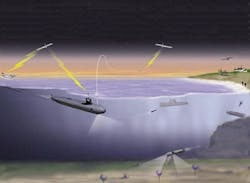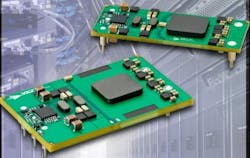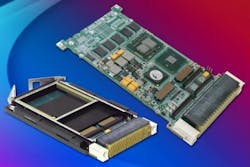The reasons for today's optimism for advanced chemical, solid-state, and fiber-optic laser technology revolve around three high-profile research projects. The first two research projects -- the Joint High Power Solid State Laser (JHPSSL) program, and the High Energy Liquid Laser Area Defense System (HELLADS) -- have largely been completed. The other program -- the Robust Electric Laser Initiative (RELI) is a follow-on project intended to capitalize on technologies developed in JHPSSL and HELLADS.
The JHPSSL and HELLADS projects have developed impressive technologies that hold out promise for lending themselves to the kinds of packaging, cooling, and fire-control capability that experts say would be suitable for future laser weapons. The RELI program seeks drastic improvements in laser efficiencies, as well as in packaging small enough for tactical aircraft and vehicles -- and could be the project that yields the technological breakthroughs that might lead to deployable laser weapons.
The JHPSSL program aimed to produce a laboratory-based, 100-kilowatt laser prototype, while HELLADS concentrated on developing 150-kilowatt laser technology. Supervising the JHPSSL program has been the High Energy Laser Joint Technology Office in Albuquerque, N.M., as well as the U.S. Army. HELLADS is sponsored by the U.S. Defense Advanced Research Projects Agency in Arlington, Va.
Plenty of obstacles must be overcome, however, before tactical laser weapons can become a reality. The military services, for example, first must demonstrate sufficient interest in laser weapons to formulate detailed requirements and find the funding necessary to bring them to deployment. High-energy laser designers, moreover, must settle on the laser technologies with the best potential for weapons and see research projects through, rather than flitting continually to the next big thing.
The JHPSSL program
Although the JHPSSL program itself has concluded, the technology the program has yielded is leading to new research efforts that may pave the way to deployment of tactical laser weapons. The U.S. companies involved in the latest phase of JHPSSL were the Northrop Grumman Corp. Aerospace Systems segment in Redondo Beach, Calif., and Textron Defense Systems in Wilmington, Mass.
"The architecture allows us to scale in power," Gregory says. "We have three knobs to turn. The first knob increases the surface area of the gain medium. The second knob involves putting slabs together with thin channels for coolant, like a sandwich. By adding more slabs to the sandwich, we can increase power. The third knob is to pump harder with the diode array pump medium by pumping harder with more diodes."
This approach, with three scaling axes, offers more efficient heat extraction than is typical for slab-type solid-state lasers, and enables Textron laser researchers to scale up to very high power while maintaining good optical quality, Gregory says. "The challenge in solid-state lasers is extracting heat," he says. "Everything not coming out of the laser is heat that needs to be removed."
In Textron's THINZAG architecture, engineers use fiber lasers to establish the initial laser beam, and then move to the THINZAG material to scale up the power of the fiber by progressively amplifying the laser, he says. Textron began participating in the third phase of JHPSSL about seven years ago, and reached a laser output power of 100 kilowatts in January 2010.
The JHPSSL program imposed several demanding parameters on its contractors that would define and lead to development of a militarily useful laser weapon, explains Dan Wildt, vice president of directed energy systems at Northrop Grumman Aerospace.
"We had to demonstrate a laser that could turn off and on in less than a second and we demonstrated six-tenths of a second," Wildt says. "We demonstrated 19 percent efficiency. It had to have good beam quality, which is really a measure of the ability to focus the beam on the target at long range. It had to have a long run time, and our laser was designed to run as long as you provide power and cooling to the system. We demonstrated 10 minutes, which is very, very long for a laser. You think of laser kill would occur in a handful of seconds."
Over the development cycle of Northrop Grumman's JHPSSL laser, company experts logged a total of more than six hours of operation at 100 kilowatts. Northrop Grumman's JHPSSL approach also uses optical slabs, which Wildt describes as "about the size of microscope slide. It is within that material that we generated the laser beam."
Overall, the JHPSSL program in its three phases demonstrated a feasible 100-kilowatt solid-state laser of military significance with "reasonable beam quality and good efficiency," says Mark Neice, director of the High Energy Laser Joint Technology Office. "Reasonable beam quality is considered to be 1.5 times the diffraction limit, and we had a goal of two times the diffraction limit," he says. We did not hit our goal, but we are close enough to move forward."
To wrap up work completed in JHPSSL, officials of the High Energy Laser Joint Technology Office will continue funding Textron's work in the laboratory to fine-tune the company's technology, and will move the Northrop Grumman JHPSSL technology to the High energy Laser Test Facility at White Sands, N.M., for field demonstration. "Northrop Grumman is transitioning from the lab to a field test environment, and we may transition the Textron laser to field tests, as well," Neice says.
The HELLADS program
The DARPA High Energy Liquid Laser Area Defense System, or HELLADS, program took a chemical laser approach and aimed at demonstrating a 150-kilowatt laser -- or 50 percent higher power than JHPSSL. Its contractors are General Atomics Aeronautical Systems Inc. in San Diego and Textron Defense Systems -- the same company involved in JHPSSL.
In developing the HELLADS prototype, one of the biggest challenges involved balancing output power with the needs for a laser pump system, laser power supply, and ability to cool the laser by removing waste heat. "Eighty percent of your size and weight is taken up with the diode pump system, power supply, and thermal management, Perry explains.
General Atomics calls its technological approach to HELLADS a distributed-gain liquid laser. "It is inherently a combination of a solid-state and a liquid laser. It has attributes of a solid-state laser combined with the efficient cooling of a liquid laser. Liquid is an integral part of the laser itself, and also is the coolant," Perry explains.
"We are developing compact power system, compact thermal storage, and other ancillary packaging we need for the system, as well as lightweight beam control," he says. General Atomics completed a prototype power system and heat-removal system last year.
One approach to enhancing the laser's efficiency involved reducing the number of diodes in the laser's pump system to reduce the overall size of the laser. "We finished a prototype of an actual system, and the program is going to the next phase," Perry says, which is to start building the full 150-kilowatt laser system. After that, DARPA will compete a contract to integrate the General Atomics laser into a prototype laser weapon system, says Richard Bagnell, the HELLADS program manager at DARPA.
Looking to the future
So, where tactical laser weapons development stands now is an established variety of technologies improving on parallel paths, yet still without an obvious front runner. The next step, which has the potential to winnow down some of the competing laser weapons technologies, is the Robust Electric Laser Initiative, better-known as RELI.
One interesting aspect of the RELI program is its target laser power -- 25 kilowatts, as opposed to the 100 kilowatts for JHPSSL and the 150 kilowatts of HELLADS. "The reason we are moving back to 25 kilowatts is we want to see a vast improvement in overall system efficiency of the laser architectures," Neice explains.
"In layman terms, JHPSSL demonstrated 100 kilowatts at less than 20 percent system efficiency, so it takes 500 kilowatts of power in to get 100 kilowatts of photons out," he says. "The new goal is to drive efficiency up to about 35 percent by simplifying the cooling and thermal management. This phase also reduces the power input and power storage requirements."
The RELI program we started last summer and now is moving through its risk-reduction phase, Neice says. "We expect within the next 12 months to review the progress of individual contractors, and will be awarding contracts for buildout of 25 kilowatt demonstration device, to be demonstrated in 2014.
In addition to the JHPSSL contractors Northrop Grumman Aerospace and Textron Defense Systems, the RELI program also will include Raytheon Space Systems in El Segundo, Calif.; the Boeing Directed Energy Program in Albuquerque N.M., and Aculight Laser Solutions, a Lockheed Martin company in Bothell, Wash., Neice says.
The first phase of the RELI program will culminate in 2014, "and then we can make decisions to push up to 100 kilowatts, based on the needs of the military services," Neice says. Partners on the RELI program are the U.S. Army and Air Force, Neice says the U.S. Navy should get involved in the program sometime next year.




